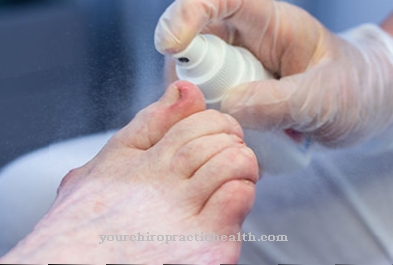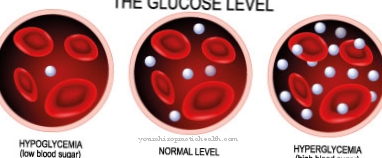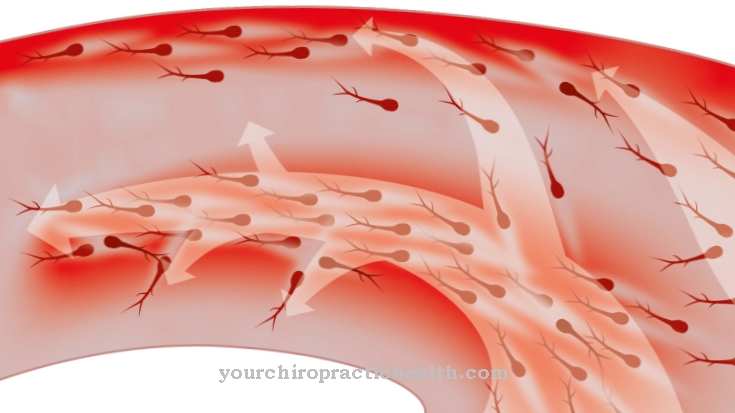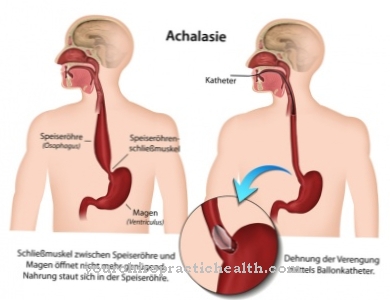As Hypertriglyceridemia is a disorder of lipid metabolism, which manifests itself in increased triglyceride values (triacylglycerides) in the blood of over 200 ml / dl. The disease can be genetic, caused by unfavorable external circumstances, or it can manifest itself as an accompaniment to other diseases. The presence of hypertriglyceridemia is often not noticed due to the lack of direct symptoms, but is considered a high risk factor for atherosclerosis and thus for myocardial infarction, inflammation of the pancreas (pancreatitis) and fatty liver.
What is hypertriglyceridemia?

© Guido Grochowski - stock.adobe.com
The word hypertriglyceridemia already indicates pathologically increased triglyceride concentrations in the blood. Generally binding limit values are 180 ml / dl to 200 ml / dl blood. If these limit values are exceeded, hypertriglyceridemia is present.
The increased concentration of triglycerides is usually associated with an increased concentration of total cholesterol, especially the long-chain LDL fraction (low density lipoprotein), which is also referred to as "bad" cholesterol when certain limit values are exceeded.
LDL cholesterols are suspected of being deposited on the inner walls of the blood vessels in the form of plaques and thus promoting arteriosclerosis. Congenital genetic defects that cause hypertriglyceridemia due to a lack of certain hormones are primary and all others are secondary or acquired.
causes
Hypertriglyceridemia can be genetic or acquired through external circumstances. It can also appear as a side effect of other diseases. A genetic disorder occurs when a deficiency in lipoprotein lipase, an enzyme that is necessary for the catalytic hydrolysis and further processing of the triglycerides, is evident.
Another genetic cause is a lack of apolipoprotein C2, which is considered to be the activator of lipoprotein lipase and can be the cause of its deficiency. External living conditions and other diseases can also lead to hypertriglyceridemia, such as: B. Obesity and excessive alcohol consumption.
Diseases that can lead to increased triglyceride concentrations up to the pathological range are above all diabetes mellitus, gout and glycogen storage diseases. The use of certain medications such as beta blockers, antivirals, and hormonal contraceptives also affect lipid metabolism and can lead to hypertriglyceridemia.
Symptoms, ailments & signs
Initially, high blood lipid levels do not cause clear symptoms. Only in the course of hypertriglyceridemia do symptoms of the cardiovascular system and internal organs develop. The development of fatty liver is typical, whereby the blood lipid values have to be greatly increased over a longer period of time.
Those affected more often feel an unspecific feeling of illness or generally feel uncomfortable without a clear cause being identified. Physical symptoms that can occur include pain in the limbs, particularly in the fingers and toes, as well as circulatory and sensory disorders. In individual cases skin changes such as xanthomas or xanthelasma occur.
These thickenings occur primarily in the knee and elbow joints and are painful when touched. Hypertriglyceridemia is rarely manifested by fat deposits in the skin or on the eyelids. However, these symptoms can also occur in healthy people. The disease can be recognized externally by the white ring in the cornea of the eye.
This so-called arcus corneau occurs after a short time and becomes more and more evident as the disease progresses. In the long term, hypertriglyceridemia can lead to hardening of the arteries. Possible long-term consequences are heart attack, stroke or thrombosis.
Diagnosis & course
Triglycerides are important for the body and are partly ingested with food, but to a large extent also synthesized in the liver, kidneys and the heart muscle. Hypertriglyceridemia is only met when a certain limit value is exceeded.
The disease, which usually does not show up with symptoms, can only be diagnosed through a laboratory test of the blood. It cannot be determined whether it is primary or acquired hypertriglyceridemia. In some cases, direct symptoms appear in the form of xanthomas or xanthelasma. In the former case, it is nodular fat deposits in the skin and in the latter case it is similar deposits below the eye.
The deposits are harmless and represent a cosmetic problem at best. If the hypertriglyceridemia persists for a longer period of time, cardiovascular diseases in particular can develop. Only an extremely high triglyceride level of over 1,000 ml / dl blood can directly trigger pancreatitis.
Complications
The main increase in hypertriglyceridemia is the risk and probability of a heart attack or fatty liver disease. Both complaints are very dangerous to health and must be avoided in any case. For this reason, hypertriglyceridemia, if left untreated, can lead to patient death and thus significantly reduce life expectancy.
In most cases, hypertriglyceridemia causes fat deposits, which can appear under the skin or under the eyes, for example. These fat deposits reduce the blood flow and thus raise the blood pressure. High blood pressure can therefore lead to a heart attack, which is not infrequently associated with the premature death of the patient.
Treatment of hypertriglyceridemia is usually done without complications. It is carried out with the help of medication that may have side effects. In rare cases, therefore, patients suffer from muscle wasting and pain in the muscles. Furthermore, psychological complaints can occur in some cases. If diagnosed and treated early, life expectancy is not affected by hypertriglyceridemia. However, irreversible damage cannot be reversed even through treatment.
When should you go to the doctor?
The disease hypertriglyceridemia requires treatment and should be examined by a doctor at the first signs. People with a high body weight, which is classified according to the specifications of the BMI in the area of obesity, need medical support. If you gain weight or try to lose weight without success, you must see a doctor. If there are malfunctions or digestive problems, a doctor must be consulted.
Check-ups are necessary if there is constipation, diarrhea or abnormal urination. Pain in the kidney area is particularly worrying and should be investigated as soon as possible. A weakness in the muscles or a decrease in normal muscle strength are indications that should be clarified by a doctor. In the event of disturbances in the heart rhythm, high blood pressure, profuse sweating or a racing heart, a doctor's visit is necessary.
If there is breathlessness, reduced mobility or problems with the joints, the person concerned needs medical help. Consultation with a doctor is essential in the event of sleep disorders, fat deposits, swellings or yellowish discoloration of the skin. Without treatment, the affected person threatens to die prematurely. Thickenings on the joints of the elbows or knees are indications that should be investigated. If there are changes in the cornea or a yellowish shade of the eyeball, a doctor should be consulted.
Doctors & therapists in your area
Treatment & Therapy
In the presence of acquired hypertriglyceridemia, the first therapeutic approach is to change the external disease-promoting circumstances. Medication should only be started if the concentration of triglycerides in the blood has not changed significantly after a few weeks, despite a change in lifestyle including exercise therapy.
It is worth noting that effective drugs to reduce triglyceride levels can only combat the symptoms, but not eliminate the root causes. Since high triglyceride levels usually come with high cholesterol levels, statins are the most effective and most commonly prescribed triglyceride and cholesterol lowering drugs. Statins block certain cholesterol-forming enzymes in the liver.
Fibrates from the group of carboxylic acids, which promote the breakdown of fatty acids and thus do not inhibit the synthesis of triglycerides but accelerate their breakdown, are an alternative to statins. Both drug groups can have side effects that can lead to myopathies with muscle pain and also muscle breakdown.
Bile acid binders, which inhibit the absorption of fats and cholesterols in the intestine, have also recently been used. For the most part, these agents have only minor side effects because they do not act systemically via the blood, but their physiological activity takes place exclusively in the digestive tract.
prevention
The most effective prevention of hypertriglyceridemia is a healthy diet with as high a proportion of natural foods as possible, the enzymes and vitamins of which are still intact. An exercise program that includes regular but not excessive physical activity is just as important.
The observance of the above measures only protect against secondary (acquired) hypertriglyceridemia, but not against the primary form of the disease. In these cases, medication that is as gentle as possible and regular laboratory checks can protect against secondary damage.
Aftercare
The aftercare measures for hypertriglyceridaemia focus on a health-conscious diet. Patients should eat natural foods as much as possible so that their bodies get intact enzymes and vitamins. In combination with an individual exercise program, the protection against deterioration of the condition is increased. However, the activities should not overload the body.
So there is more and more gentle sport to be done regularly, which is typically a moderate endurance training. However, such aftercare is only suitable for treating the secondary disease. In the case of a primary disease, other measures are used.
Here, the doctor usually recommends moderate medication and close laboratory control in order to identify secondary damage in good time. The healthier way of life should be consistently adhered to later in everyday life. This improves the blood values, as the regular examinations show. The doctor also recommends weight loss in overweight patients.
Reduced-fat foods and avoiding animal fats support recovery. Sweet, sugary drinks and meals as well as white flour baked goods should disappear from the menu or only be consumed in small quantities. Recommended foods with omega-3 fatty acids include nuts, sea fish, and linseed oil.
You can do that yourself
Since triglycerides are ingested directly with food on the one hand and can be produced by the body itself from carbohydrates on the other, diet can make an important contribution to lowering the triglyceride level in the blood. This is especially the case with the acquired form of hypertriglyceridemia.
Since many of those affected are overweight, weight reduction and lifestyle changes are essential. For this purpose, a low-fat diet should be followed, in particular animal fats should be avoided. We recommend foods with a high content of saturated omega-3 fatty acids, such as nuts, linseed oil and sea fish. Sugar and sugary foods such as desserts, fruit juices or baked goods should be avoided as far as possible, as the body uses them to generate additional triglycerides. It is possible to replace it with sweeteners, as they have no effect on the fats. Those affected should completely avoid alcohol if possible, it also contains many carbohydrates for the formation of further fats.
In addition to a change in diet, regular exercise can also counteract the increased blood lipid levels. It is advisable to do moderate endurance training of at least 30 minutes three to five times a week.


.jpg)









.jpg)



.jpg)










.jpg)
